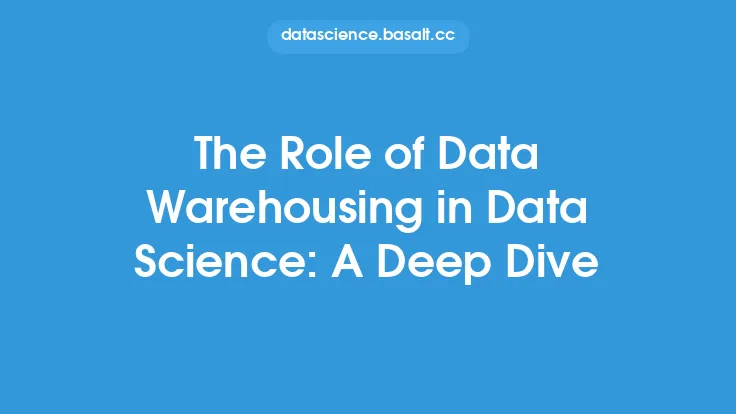The concept of data lakes has been around for several years, and it has become a crucial component of modern data engineering. A data lake is a centralized repository that stores raw, unprocessed data in its native format, allowing for flexible and scalable data analysis. With the advent of cloud computing, cloud-based data lakes have emerged as a popular choice for organizations looking to leverage the scalability, flexibility, and cost-effectiveness of the cloud. In this article, we will delve into the architecture and implementation of cloud-based data lakes, exploring the key components, benefits, and best practices.
Introduction to Cloud-Based Data Lakes
A cloud-based data lake is a data storage and processing system that is built on top of a cloud-based infrastructure. It is designed to store and process large amounts of raw, unprocessed data in a scalable and flexible manner. Cloud-based data lakes are typically built using a combination of cloud-based storage services, such as Amazon S3, Azure Data Lake Storage, or Google Cloud Storage, and processing engines, such as Apache Spark, Apache Hadoop, or Apache Flink. The use of cloud-based infrastructure provides a number of benefits, including scalability, flexibility, and cost-effectiveness.
Architecture of Cloud-Based Data Lakes
The architecture of a cloud-based data lake typically consists of several key components, including:
- Data Ingestion: This component is responsible for collecting and loading data into the data lake. Data ingestion can be done using a variety of tools and techniques, such as Apache NiFi, Apache Kafka, or AWS Kinesis.
- Data Storage: This component is responsible for storing the raw, unprocessed data in the data lake. Cloud-based storage services, such as Amazon S3, Azure Data Lake Storage, or Google Cloud Storage, are commonly used for this purpose.
- Data Processing: This component is responsible for processing and analyzing the data in the data lake. Processing engines, such as Apache Spark, Apache Hadoop, or Apache Flink, are commonly used for this purpose.
- Data Governance: This component is responsible for managing and governing the data in the data lake. Data governance includes tasks such as data quality, data security, and data compliance.
- Data Analytics: This component is responsible for analyzing and visualizing the data in the data lake. Data analytics tools, such as Tableau, Power BI, or D3.js, are commonly used for this purpose.
Benefits of Cloud-Based Data Lakes
Cloud-based data lakes offer a number of benefits, including:
- Scalability: Cloud-based data lakes can scale to handle large amounts of data and processing workloads.
- Flexibility: Cloud-based data lakes can handle a variety of data formats and processing workloads.
- Cost-Effectiveness: Cloud-based data lakes can be more cost-effective than traditional on-premises data lakes.
- Faster Time-to-Insight: Cloud-based data lakes can provide faster time-to-insight, as data can be processed and analyzed in real-time.
Implementation of Cloud-Based Data Lakes
Implementing a cloud-based data lake requires careful planning and execution. The following are some best practices to consider:
- Choose the Right Cloud Provider: Choose a cloud provider that meets your organization's needs and requirements.
- Design a Scalable Architecture: Design a scalable architecture that can handle large amounts of data and processing workloads.
- Implement Data Governance: Implement data governance policies and procedures to ensure data quality, security, and compliance.
- Use Cloud-Based Tools and Services: Use cloud-based tools and services, such as Apache Spark, Apache Hadoop, or Apache Flink, to process and analyze data.
- Monitor and Optimize: Monitor and optimize the performance of the data lake, using tools such as Apache Airflow or AWS CloudWatch.
Security and Compliance in Cloud-Based Data Lakes
Security and compliance are critical components of cloud-based data lakes. The following are some best practices to consider:
- Use Encryption: Use encryption to protect data in transit and at rest.
- Implement Access Controls: Implement access controls, such as authentication and authorization, to ensure that only authorized users can access the data lake.
- Use Cloud-Based Security Services: Use cloud-based security services, such as AWS IAM or Azure Active Directory, to manage access and identity.
- Comply with Regulations: Comply with regulations, such as GDPR or HIPAA, to ensure that the data lake meets the required standards.
Data Processing and Analytics in Cloud-Based Data Lakes
Data processing and analytics are critical components of cloud-based data lakes. The following are some best practices to consider:
- Use Cloud-Based Processing Engines: Use cloud-based processing engines, such as Apache Spark, Apache Hadoop, or Apache Flink, to process and analyze data.
- Use Cloud-Based Analytics Tools: Use cloud-based analytics tools, such as Tableau, Power BI, or D3.js, to analyze and visualize data.
- Implement Real-Time Processing: Implement real-time processing, using tools such as Apache Kafka or AWS Kinesis, to provide faster time-to-insight.
- Use Machine Learning and AI: Use machine learning and AI, using tools such as Apache MLlib or Google Cloud AI Platform, to provide predictive analytics and insights.
Conclusion
Cloud-based data lakes are a powerful tool for organizations looking to leverage the scalability, flexibility, and cost-effectiveness of the cloud. By understanding the architecture and implementation of cloud-based data lakes, organizations can unlock the full potential of their data and provide faster time-to-insight. By following best practices, such as choosing the right cloud provider, designing a scalable architecture, and implementing data governance, organizations can ensure that their cloud-based data lake is secure, compliant, and provides the required insights and analytics.





